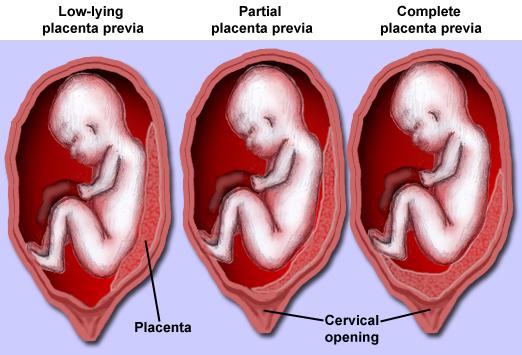
-
What is the placenta?
-
What is placenta previa and how common is it?
-
Are there different types of placenta previa?
-
Symptoms, diagnosis and complications
-
Is there treatment available?
-
Are there certain things I need to avoid?
-
How to cope with a diagnosis of placenta previa
What is the placenta?
The placenta is a vital organ which attaches to the uterus (womb) during pregnancy. It is the connection between you and your growing baby and its health and placement plays a vital role in how your baby receives nutrients and oxygen and is able to clear waste products from its blood. The placenta develops after the embryo has implanted into the uterine wall and its implantation determines placental placement. Most commonly the placenta attaches to the top or side of the uterus and from it grows the umbilical cord, however, in the case of placenta previa, the placenta attaches close to or completely on top of the cervix. The cervix is the lowermost portion of the uterus which allows for the passage of menstrual blood, the passage of sperm into the uterus and also the passage of the baby during birth.
What is placenta previa and how common is it?
Placenta previa is when the placenta implants at or close to the internal os (mouth) of the cervix. At times it can completely cover the cervix; it occurs in 1 in 200 pregnancies. While the causes of placenta previa are not known there are certain factors that place you at a higher risk for developing placenta previa. These include:
- Cigarette smoking
- Cocaine use
- Age: Under 20 or over 35
- Prior pregnancies and/or pregnancies with more than one fetus (multiples)
- Prior uterine surgery such as a prior C-section, D&C (dilation and curettage), fibroid removal or other.
- Prior placenta previa raises your risk of another placenta previa by 2-3 percent
Are there different types of placenta previa?
There are four types of placenta previa and are described below.
- Complete placenta previa: the placenta is completely covering the internal portion of the cervix.
- Partial placenta previa: the placenta is only partially covering the internal portion of the cervix.
- Marginal placenta previa: the placenta is located next to the internal portion of the cervix.
- Low lying placenta previa: the placenta is located within two centimeters of the internal portion of the cervix however is not directly next to the os.
Symptoms, diagnosis and complications
Most commonly, your doctor will diagnose placenta previa during your second-trimester ultrasound however symptoms may be present before that time and include painless bright red light to heavy vaginal bleeding during the second half of your pregnancy. Contractions may or may not be present with placenta previa. If you experience these symptoms, it is important to call your healthcare provider right away or seek immediate medical attention if the bleeding is very heavy. Most cases of placenta previa will resolve on their own when found in the second trimester, however, it is important to speak with your doctor about your specific situation. Complications of placenta previa may include severe maternal bleeding (hemorrhage) and pre-term birth.
Is there treatment available?
Treatment of placenta previa depends on your specific situation and symptoms. In most cases, a C-section will be recommended instead of having a vaginal birth. Treatment of placenta previa can range from monitoring you and your baby closely in a hospital to undergoing blood transfusions if your bleeding is severe. In these more severe cases, you may be treated with corticosteroids to accelerate your baby’s lung and organ development to prepare for an early delivery.
Your physician may recommend an immediate C-section under certain circumstances. For example, if your bleeding is severe and you are approximately 34-36 week s pregnant or if by 36-37 weeks pregnancy your baby’s lungs are proven to be fully developed after testing your amniotic fluid by undergoing an amniocentesis.3 Despite the goal to keep you pregnant for as long as possible, if your bleeding is life-threatening or there are serious concerns about you and your baby’s health, a C-section may be required despite your actual due date.
Are there certain things I need to avoid?
Depending on your specific situation including the type of placenta previa, amount of vaginal bleeding, etc, there may be things you should avoid. If you are not experiencing vaginal bleeding or the bleeding is light, you may be required to be on at home bed rest. Specific instructions on the duration and type of bed rest required will be discussed with you by your healthcare provider. Other things to avoid are sexual intercourse and exercise.
If your bleeding is heavy or severe you may be required to be admitted to the hospital on bed rest and observed by your healthcare team. At times, blood transfusions and medications to prevent preterm labor may be necessary. In life-threatening cases, an immediate c-section may be necessary.
How to cope with a diagnosis of placenta previa
The diagnosis of placenta previa can be quite distressing however there are things that you can do to cope such as:
- Becoming educated on placenta previa.
- Prepare yourself for a possible c-section.
- Make the most of being on bed rest and take care of yourself by preparing for your new arrival or catching up with old friends, etc.
Sources:
- Placenta: How It Works, What’s Normal. Mayo Clinic. Accessed January 27, 2015.
- Placenta Previa. Mayo Clinic. Accessed January 27, 2015.
- Placenta Previa. March of Dimes. Accessed January 28, 2015.
- Placenta Accreta and Percreta: Incidence, Risks, Diagnosis, Counseling and Preparation for Delivery. California Maternal Quality Care Collaborative. Accessed January 28, 2015
